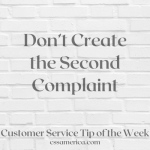The nurses.com article Discharge calls help nurses affect readmission rates, patient satisfaction notes that an increasing trend of calling patients post-discharge is having positive effects on patient outcomes and satisfaction. At one hospital, the calls involve social workers contacting patients to gauge the patient’s mindset (“psychosocial” state) as well as determine whether they’re getting their clinical needs met.
Generalizing what’s done here to apply to any industry, the customer is contacted soon after the transaction to gauge satisfaction (i.e., how they’re feeling mentally) and to follow-up to ensure that whatever next steps were identified are being addressed.
But before we say “this is too much work to contact every patient or customer…” after every encounter, let’s focus on another finding in the article. One facility looks at the home care population, and a member of management stated that “we stratify them into high risk, moderate risk and low risk. If they are high risk, they will also have a nurse practitioner with a specialty in heart failure either calling them or visiting their home within 72 hours of discharge.”
This is the key to being efficient and most effective – stratifying your patient base. Organizations that want to drive high levels of patient satisfaction need to realize that they must keep relationships fresh, they must gauge patient perceptions post-discharge, they must ensure that appropriate follow-up and compliance with post-discharge instructions are occurring. But they also must NOT view every patient the same.
Some patients are more at-risk of readmission, more likely not to return if dissatisfied, more driven to be satisfied/dissatisfied based on their relationship with the organization.
When you look to reduce readmissions and improve patient satisfaction, do the necessary follow-up and relationship-building in a targeted manner to make those improvements with efficiencies.
Remember that patient satisfaction is often driven by what you do AFTER they leave.
Interested in improving your hospital’s patient satisfaction? See our other blog posts at: http://serviceadvice.cssamerica.com/category/healthcare/
Check out our patient satisfaction improvement services at: http://cssamerica.com/csshealth.htm





















